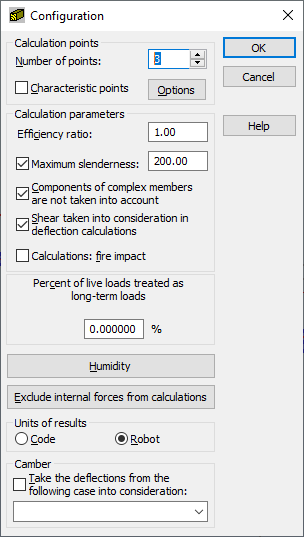Use the Configuration dialog to define the parameters applied during verification of a timber member (codes CB71 and EC5). Access the dialog by clicking the Configuration button in the Calculations dialog. The following dialog displays (the dialog for the CB71 code):

The following calculation parameters are defined:
- Calculation points; they are defined in two ways:
- By defining the number of points along the member length (the points are evenly distributed along the member length) - the Number of points option
- By defining coordinates of the characteristic points; select the Characteristic points option and press the Options button; the Calculations in Characteristic Points dialog opens.
- Efficiency ratio determines the coefficient by which the yield point will be multiplied (increase or decrease of the yield point)
- Maximum slenderness; if the option is selected, the member slenderness is verified. Moreover, you can define the allowable value of member slenderness.
If the Components of complex members are not taken into account option is selected, then the components of these members will not be included during calculations of complex bars.
If the Shear taken into consideration in deflection calculations option is selected, then the shear influence will be taken into account when calculating deflection. When the Calculations: fire impact option is activated, then in the course of calculations, a member whose section has been slightly burned will undergo analysis.
A value provided in the Percent of live loads treated as long-term loads field is used while calculating the amplification coefficient.
A selected value of average timber humidity affects calculations of reduction factors for resistance (during compression and bending): humflex and humcom.
Use the Load Case Classification - Duration button to access the Eurocode 5. An additional dialog is displayed in which load classes may be assigned to the user-defined simple load cases. Depending on the load duration, a value of the coefficient of timber resistance modification (kmod) is determined.
For the code CB71 there is additionally the Humidity button available; clicking this button opens the Timber Humidity dialog where parameters of timber humidity are defined.
Click the Exclude internal forces from calculations button to open the new Internal forces not taken into consideration dialog. This dialog includes options that define the limit values of internal forces (thus the force values that are 'negligible' for a specific section may be disregarded). Moreover, the units for presentation of member design results are selected. The results are presented in the units used in the selected timber code, or in the units applied in Robot
The lower part of the dialog contains a list used to select a load case (dead load), for which the displacements defined will be treated as structure camber. The option Take the deflections from the following case into consideration must be selected to activate the load case list.
See also:
